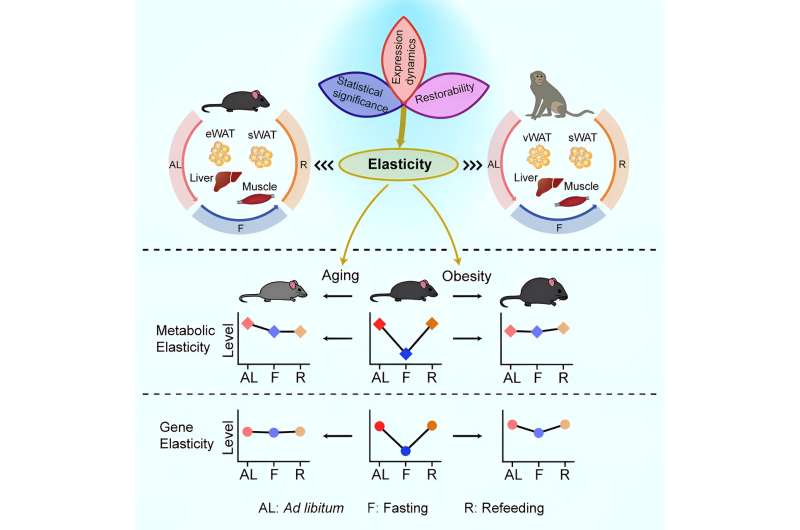
Scientists from Duke-NUS Medical School, in collaboration with counterparts from Columbia University, have developed a new framework to measure metabolic health. The concept of “metabolic elasticity” paints a more comprehensive picture of how the body reacts to changes in the availability of food and how efficiently the food is converted into energy. Their findings, published in Cell Metabolism, provide novel perspectives to develop new ways of screening for metabolic health.
While it has been well-established that our metabolism slows with age, current measurements to assess the deterioration typically capture a single state and do not reflect the changes that occur in the digestive process. To illustrate, when an individual goes without food, their metabolism slows down. When they resume eating, their metabolic rate increases. The body has to constantly adapt its metabolism accordingly—from being at rest, to activation and then back to its original state.
To take into account such transitions, Duke-NUS scientists and their collaborators from Columbia University tracked changes in key metabolic organs across a cycle of at-rest, fasting and re-feeding. They found that the faster the body can reduce and subsequently restore its metabolic parameters such as levels of glucose, insulin (a hormone that helps the body turn food into energy) and fats, the better its metabolic elasticity is. This in turn, sheds light on the overall health of one’s metabolism.
“Our study introduces metabolic elasticity as an effective means of assessing and screening for metabolic health. We foresee this concept of elasticity extending to conditions beyond aging and obesity, including diabetes, exercise, cancer, and many others. We expect that all of these conditions can be reframed as dynamic and elastic processes rather than solely as snapshots of single metabolic states or transitions,” said first author Zhou Qiuzhong, a senior research fellow from the Cardiovascular and Metabolic Disorders Program at Duke-NUS.
Delving deeper, the researchers found that metabolic elasticity is determined by how easily genes that control metabolism activate, and de-activate. Describing this as gene elasticity, they found that it is present mainly in cells that have metabolic functions in various organs. For example, in fatty tissue, the most elastic genes are expressed in cells that store energy as fat.
The scientists then tested the concept to explore the impact of aging and obesity on metabolic health. They discovered that both age and obesity blunt metabolic elasticity, weakening the dynamism of many metabolic parameters, including fat and lean tissues, as well as blood glucose.
Diets also affect metabolic elasticity. In pre-clinical trials, a six-week intermittent fasting regime improved metabolic elasticity, while a high-fat diet that induced obesity saw metabolic elasticity decline. The changes reversed after switching back to a normal diet in younger groups. Notably, in older aged groups, this reversal was not observed/much reduced, again highlighting how age impairs metabolic elasticity.
“Metabolic elasticity can be likened to a spring. When it is new, it can stretch and revert to its original shape easily. But with age and obesity, it deteriorates—losing its elasticity and becoming overstretched. As a screening tool, it can help us to highlight warning signs of such declines in our metabolism so that we can take measures to make lifestyle changes for better health,” said corresponding author, Associate Professor Sun Lei from the Cardiovascular and Metabolic Disorders Program at Duke-NUS.
“Aging and obesity are among the most critical health issues that people worldwide are grappling with today. These findings reveal a new aspect of how metabolism deteriorates in these conditions. Such insights can help us develop new strategies to combat these prevalent health challenges, prevent or delay metabolic dysfunction and potentially extend healthspan,” said Professor Patrick Tan, senior vice-dean for research, Duke-NUS.
The team hopes to conduct more studies on how specific genes and pathways can cause metabolic elasticity to decline in aging and obesity. They will then design strategies to boost elasticity, potentially stemming overall metabolic decline to improve health and well-being.
More information:
Qiuzhong Zhou et al, Deciphering the decline of metabolic elasticity in aging and obesity, Cell Metabolism (2023). DOI: 10.1016/j.cmet.2023.08.001
Journal information:
Cell Metabolism
Source: Read Full Article
